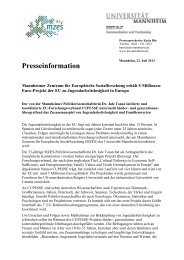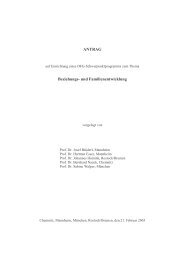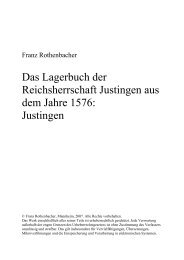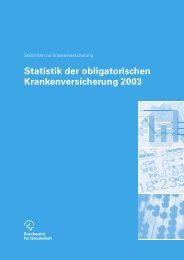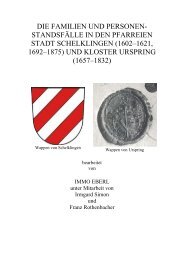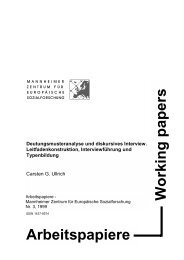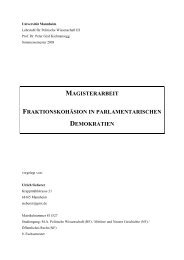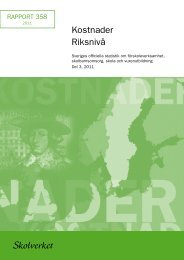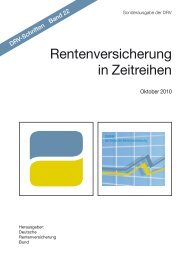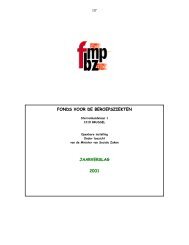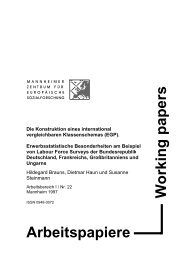Tobias Auberger and Tanja Hitzel-Cassagnes - Mzes
Tobias Auberger and Tanja Hitzel-Cassagnes - Mzes
Tobias Auberger and Tanja Hitzel-Cassagnes - Mzes
Create successful ePaper yourself
Turn your PDF publications into a flip-book with our unique Google optimized e-Paper software.
15<br />
hierarchies <strong>and</strong> asymmetries are – in a way – “invisibilised”. Regarding enlargement, i.e.,<br />
regarding the integration of a new set of actors manoeuvring in these processes without disposing<br />
yet of the institutional experience <strong>and</strong> knowledge but in the need to canalise <strong>and</strong> integrate<br />
various concerns <strong>and</strong> interests, it does not seem to be too far fetched to imagine<br />
them in a potential asymmetric situation. This potentiality of structural asymmetry is,<br />
however – as we have tried to point out –, not genuinely an effect of enlargement but rather<br />
a constitutive attribute of European politics in its present shape. Profitable in general normative<br />
terms <strong>and</strong> surely in practical terms for the new member states would be to render<br />
these processes more transparent <strong>and</strong> procedurally more formalised: By these means the<br />
need to argue for <strong>and</strong> to justify inequality, hierarchy <strong>and</strong> power-asymmetries would rise <strong>and</strong><br />
processes of justification trying to figure out solutions acceptable to all those concerned<br />
could be furnished.<br />
3.4. Concepts of law<br />
The qualification of the Union as a “Community of law” (Rechtsgemeinschaft) <strong>and</strong> the notions<br />
of the idea of “integration through law” highlight the status of law as a constitutive<br />
principle of the Unions architecture <strong>and</strong> functioning as well as its practical relevance in<br />
guaranteeing the ‘proper’ functioning of the integration-process (see Graig/de Burca 1999).<br />
That is to say, the functioning of the European integration project is based on the rule of<br />
law on the one h<strong>and</strong>, on legal <strong>and</strong> juridical instruments of policy-formation <strong>and</strong> -implementation,<br />
<strong>and</strong> highly relies on a compound scheme of legal enforcement integrating national<br />
judiciaries at all levels of the legal systems. In the course of the European judicial attempts<br />
to enforce the uniform application of European law there have always been conflicts<br />
about the status of European law <strong>and</strong>, at the other side of the medal, conflicts about the integrity<br />
of the national constitutional systems <strong>and</strong> about competence-allocations (esp. with<br />
regard to, firstly, the role of individual <strong>and</strong> human rights, <strong>and</strong>, secondly, of democratic<br />
rights <strong>and</strong> organisational principles). And as we can observe right now, there are quite similar<br />
disputes between the ECJ <strong>and</strong> the highest <strong>and</strong> constitutional courts of the new member<br />
states as have been taking place since the 1970s between the ECJ <strong>and</strong> the German <strong>and</strong> Italian<br />
constitutional as well as the French higher courts (see Albi 2004, Capeta 2005 <strong>and</strong> 2006,<br />
Kowalik-Banczyk 2005, Kühn 2004 <strong>and</strong> 2005, Lefevre 2004).



